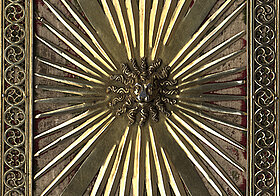Due to a police closure of Josefsplatz, the State Hall will open on Tuesday, October 21, starting 12 noon only.
Due to an event, the State Hall will be closed on Wednesday, October 22, 2025 from 2.30 p.m.
Due to an event, the State Hall will be closed on Friday, October 31, from 3 p.m.
The beginnings of the imperial library, the precursor to today’s National Library, can be traced back to medieval Europe. In addition to jewels, gems, and all kinds of curiosities, the treasure chambers of the worldly regents also held the most valuable books, which had either been inherited or were specially commissioned works. These treasures had not only a high material value, but above all also a symbolic and sacred one. It is therefore not surprising that the treasure chambers of the Middle Ages were mostly found at holy places.
Similarly, in Vienna the treasure of Duke Albrecht III (1349 or 1350–1395) was kept in two sacristies in the south-corner tower of the chapel in the duke’s castle. A passionate art connoisseur, the duke promoted the University of Vienna, saw to the translation of Latin works into the country’s language, and established a book illumination workshop at the court. What is verifiably the oldest book now owned by the Austrian National Library comes from the duke’s collection: in 1368, Johannes von Troppau, the canon of Brno and priest of Lanškroun, produced for him a Gospel Book written in gold letters and elaborately illuminated in the visual language of Bohemian book illustration (ÖNB, Codex 1182). A page showing scenes from the lives of the four Evangelists is decorated with four coats of arms at the corners: those of the House of Austria, Styria, Tyrol, and Carinthia – the provinces over which Albrecht III reigned at the time.



